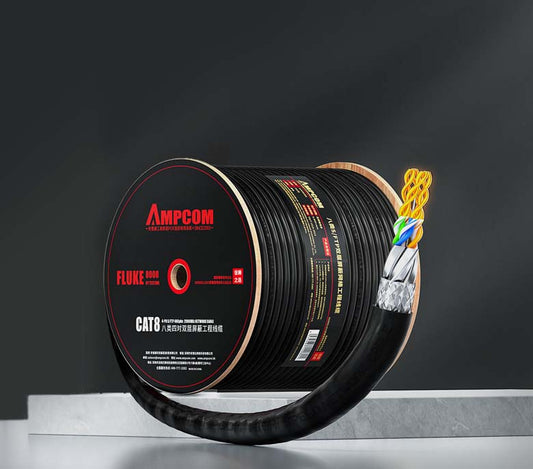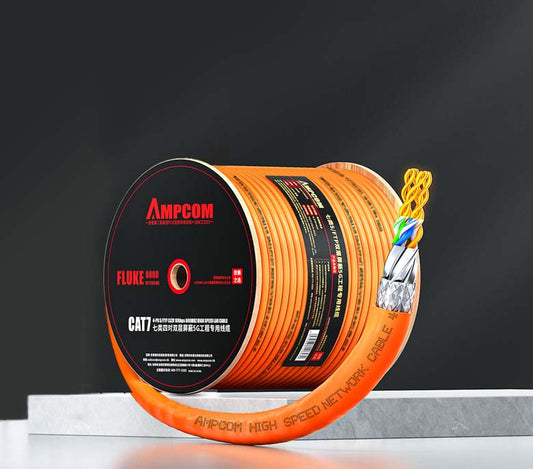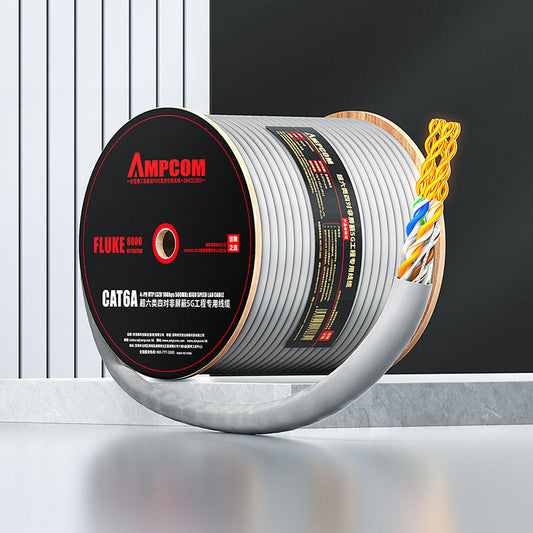From "Chaos" to "Order": The Importance and Best Practices of Data Center Cable Management
Introduction: Stepping into a modern data center, the first things you often see are the densely packed server racks, the humming cooling equipment, and most impressively—the maze of patch cables connecting everything, sprawling like a spider web across the space.
These cables, carrying the flow of data, are the "arteries" of the data center's network architecture.
However, in many data centers, especially those built early on or poorly managed, these "arteries" often appear in a state of disarray: cables tangled randomly, labels faded or unclear, port connections jumbled.
This chaos not only affects aesthetics but also hides significant risks.
This article will delve into the importance of data center cable management, analyze the problems caused by messy cables, and share a systematic set of best practices for cable management to help data centers transform from "chaos" to "order."

1. The Cost of "Chaos": Hidden Risks of Poor Cable Management
Cable management may seem like a basic and trivial task, but its importance is often underestimated.
A disorganized cable environment brings a series of direct or indirect negative impacts:
- Difficulty in Troubleshooting, Low Operational Efficiency: This is the most direct impact. When network issues occur, if cables lack clear identification and records, troubleshooting becomes like searching for a needle in a haystack. Engineers need to spend a lot of time tracing the origin and destination of a single cable, and may even need to plug and unplug cables for individual testing. This not only extends the time to fix the fault but also increases the risk of misoperations. Statistics show that a significant portion of network faults are related to cabling problems, with messy cable management being a primary cause.
- Increased Risk of Human Error: In a chaotic cable environment, engineers are more likely to make mistakes when performing any network changes, adding, or removing equipment. For example, incorrectly plugging a cable into the wrong port could lead to network outages or configuration errors, even damaging equipment. Such human errors are particularly dangerous in high-pressure, high-density data center environments.
- Hindering Network Upgrades and Expansion: As business grows, data center networks need constant upgrades and expansion. If existing cable management is chaotic, upgrade work becomes exceptionally difficult. Adding new ports, replacing switches, deploying new servers can all be hindered by not being able to find suitable ports or track connection relationships. This not only increases upgrade costs but may also miss opportunities for business development.
- Impact on Cooling and Energy Consumption: Tangled cables severely obstruct airflow within the racks, causing servers and switches to overheat, reducing performance, and potentially shortening their lifespan. At the same time, to compensate for insufficient cooling, it may be necessary to increase the cooling power, leading to higher energy consumption. An orderly cable layout ensures smooth cold and hot aisles, optimizing cooling efficiency.
- Hindering Automated Operations: Modern data centers are moving towards automated operations. Whether it's configuration management tools, network monitoring systems, or automated test scripts, they all require accurate data input. Chaotic cable management prevents these tools from obtaining accurate connection information, rendering them ineffective. Achieving true network automation relies on clear and accurate cable records.
- Compliance Risks: Certain industries or regions may have compliance requirements regarding data center cabling management. Messy cable management might lead to failure to meet these requirements, creating compliance risks.

2. The Value of "Order": Core Benefits of Cable Management
In stark contrast to the chaotic state, a well-managed cable environment brings significant benefits:
- Improved Operational Efficiency, Shorter Time to Repair: Clear labels and organized placement allow any cable to be quickly located and identified. When network problems arise, engineers can quickly find the relevant cables, rapidly determine the source of the problem, significantly reducing Mean Time To Repair (MTTR) and ensuring business continuity.
- Reduced Human Error Rate, Increased Network Stability: Standardized cable procedures and clear identification reduce the possibility of operational errors. Every change becomes controllable and traceable, improving the overall stability of the network.
- Accelerated Network Changes and Expansion: Clear cable records and physical layout make adding new equipment, ports, or replacing equipment simple and quick. Whether for routine maintenance or handling business peaks, network configurations can be adjusted more从容ly.
- Optimized Cooling, Reduced Energy Consumption: Reasonable cable placement, combined with cold/hot aisle design, significantly improves airflow organization within racks, increases cooling efficiency, reduces equipment failure rates, and may lower overall energy consumption.
- Support for Automation and Intelligent Operations: Clear and accurate cable records are the foundation for automated operations. Only when the system "knows" the exact location and connection relationship of each cable can automatic discovery, configuration, monitoring, and intelligent analysis be achieved.
- Enhanced Professional Image, Easier Audits: A neat and orderly cable environment itself is a reflection of a data center's professional management level and can better meet the requirements of internal or external audits.
-
Application and Customized Design of Cable Tracers in Specific Industries

3. From "Chaos" to "Order": Best Practices for Cable Management
Achieving "order" in cable management is not an overnight task; it requires systematic planning and continuous effort. Here is a set of actionable best practices:
-
Establish Clear Cable Management Standards:
- Standardized Labeling System: This is the "ID card" for cables. Standards should specify the content of labels (e.g., port number, device name, connection target, color coding), size, material, and placement location. For example, a "Start-End" format like "SW-A-1-P1 → SVR-B-1-P1" can be used, or a more complex coding system. Color coding can distinguish different types (e.g., network, storage, management) or different zones.
- Cable Routing Standards: Specify that cables should be routed along designated paths (e.g., trays, conduits) and avoid random hanging or crossing. Specify the maximum bend radius to prevent cable damage from excessive bending. Specify that cables should not cross cold/hot aisles.
- Cable Organization Standards: Specify the use of zip ties, cable ties, or raceways to organize cables moderately, avoiding excessive bundling that could damage the cables. Specify that cables should not be too densely packed to ensure smooth airflow.
- Change Management Process: Clearly define that any cable operation (addition, removal, replacement) must follow a standard change process, including request, approval, execution, documentation, and testing.
-
Select Appropriate Cables and Connectors:
- Quality First: Choose cables and connectors from reputable brands that meet relevant standards to ensure their performance and reliability.
- Type Matching: Select the appropriate category (Cat5e, Cat6, Cat6a, Cat7, Cat8) based on network requirements. Ensure the cable category matches the connected device ports and the category of the cabling system.
- Consider Shielding Needs: In environments with strong electromagnetic interference, prioritize shielded cables (e.g., S/FTP, OFNP) and ensure the connectors and termination processes meet shielding requirements.
- Consider Cable Length: Avoid using excessively long cables, which are wasteful and may affect performance due to signal attenuation. It's recommended to use standard lengths (e.g., 0.5m, 1m, 3m, 5m, 7m, 10m, etc.) and consider using cable managers to adjust the final connection length.
-
Implement Structured Cabling and Patch Panel Management:
- Follow Standards: Follow standards like TIA/EIA-568 or ISO/IEC 11801 for cabling design, using a star topology.
- Patch Panel Identification: Clearly number each patch panel and draw detailed port distribution diagrams. Use labels at the patch panel terminals to clearly mark the corresponding rack, row number, port information, etc.
- Port Labeling: At device ports (switches, servers, rack PDUs, etc.), use labels to clearly mark the device name, port number, and other information.
-
Establish and Maintain a Cable Asset Management System:
- Manual Records: For small data centers, spreadsheets (like Excel) can be used to record the start point, end point, label information, installation date, etc., for each cable. Update records promptly with every change.
- Professional Cable Management System: For medium to large data centers, it's recommended to use a professional cable management system (CMMS - Cable Management System). These systems typically offer graphical interfaces that visually display the connection relationships between racks, patch panels, and cables. They support barcode or RFID label scanning for quick data entry and updates. More importantly, they can integrate with CMDBs, network monitoring systems, and other systems to achieve data synchronization and联动.
- Regular Audits: Conduct regular audits of cable assets (e.g., quarterly or semi-annually) to verify if the actual cable connections match the system records, identifying and correcting errors promptly.
-
Use Efficient Cable Organization and Fastening Tools:
- Cable Managers: Inside the rack, use cable managers to organize and secure cables. They can provide preset channels or dividers, making cables orderly and effectively separating different types of traffic (e.g., network, storage). Choose the appropriate type (e.g., vertical, horizontal, open, enclosed) and size.
- Zip Ties and Cable Ties: Use nylon zip ties or cable ties to moderately bundle cables. Be careful not to tie them too tightly, which could damage the cables. It's recommended to use releasable zip ties for easier future adjustments.
- Cable Trays/Conduits: Between racks or in cable pathways, use trays or conduits to guide cables, preventing them from lying scattered.
-
Training and Culture Building:
- Full Staff Training: Train all employees who might handle cables (engineers, operations staff, maintenance personnel) on the cable management standards, ensuring everyone understands the rules and can operate correctly.
- Emphasize Culture: Treat cable management as a fundamental and important task, not an optional add-on. Emphasize the importance of good cable management for improving efficiency, reducing faults, and ensuring safety.
-
Regular Maintenance and Inspection:
- Regular Inspections: Incorporate cable inspections into regular maintenance or routine inspection schedules. Check for physical damage, signs of aging, secure connections, clear and readable labels, and whether the overall layout remains organized.
- Timely Repairs: Address issues (e.g., fallen labels, cable damage, messy layouts) immediately to prevent small problems from becoming major hazards.

4. Intelligence and Automation: Future Trends in Cable Management
With technological advancements, cable management is also moving towards greater intelligence and automation:
- Smart Cable Management Systems: Cables integrated with sensors and IoT technology can monitor connection status, traffic load, temperature, and other parameters in real-time, transmitting data to a central management system. This makes fault prediction and performance optimization possible.
- Automated Cabling Robots: In large data centers or complex cabling environments, robots can assist or even fully automate the routing, organization, and connection of cables, significantly improving efficiency and accuracy.
- AI-Assisted Analysis: Using AI to analyze cable usage data, fault records, etc., can predict potential risks, optimize cable configurations, and even provide automated cable organization suggestions.
-
Investment vs. Return: Evaluating the Value of Cat7/Cat8 Cables in Data Centers and HPC
While these technologies may still be in the early stages of application or exploration, they represent the future direction of cable management, heralding a more efficient and reliable model for network infrastructure operations.
5. Conclusion: Refined Management, Building a Solid Network Foundation
Cable management, seemingly a "small matter" in network operations, actually affects the entire network's "health" and "lifespan."
A disorganized, chaotic cable environment not only increases the difficulty and cost of daily operations but can also trigger network failures at critical moments, leading to business interruptions and data loss. Conversely, a neat, orderly, and traceable cable environment significantly enhances the network's maintainability, reliability, and security, providing a solid physical foundation for stable business operations.
Therefore, whether for businesses building networks for the first time or managers looking to optimize existing network environments, cable management should be given high priority. From establishing clear standards to selecting appropriate tools, to fostering good operational habits, every step is crucial. By implementing the strategies outlined above, we can transform cables from potential "troublemakers" into reliable and efficient components of the network architecture, better supporting the growing and increasingly complex demands of network applications and building an unshakeable foundation for the network.



